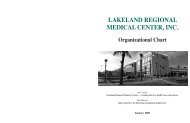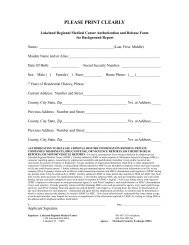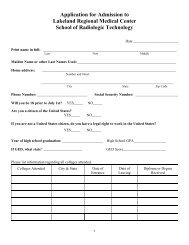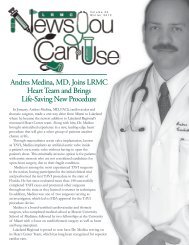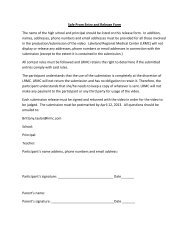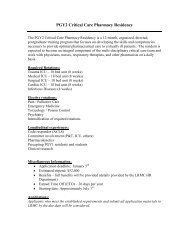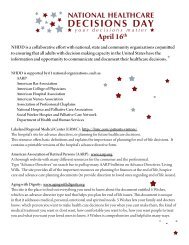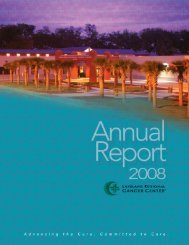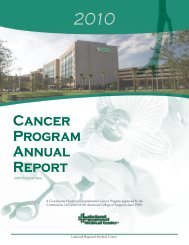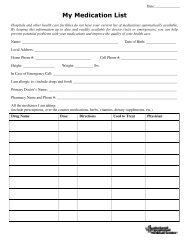School of Radiologic Technology - Lakeland Regional Medical Center
School of Radiologic Technology - Lakeland Regional Medical Center
School of Radiologic Technology - Lakeland Regional Medical Center
You also want an ePaper? Increase the reach of your titles
YUMPU automatically turns print PDFs into web optimized ePapers that Google loves.
<strong>School</strong> <strong>of</strong><br />
<strong>Radiologic</strong><br />
<strong>Technology</strong>
WELCOME.........<br />
LAKELAND REGIONAL MEDICAL CENTER<br />
SCHOOL OF RADIOLOGIC TECHNOLOGY<br />
Welcome to the exciting field <strong>of</strong> <strong>Radiologic</strong> <strong>Technology</strong>. As you read through this catalog, you will be taking<br />
your first step into a fascinating career in one <strong>of</strong> today's most vital health care fields.<br />
As a <strong>Radiologic</strong> Technologist, you are part <strong>of</strong> a highly educated team <strong>of</strong> health care pr<strong>of</strong>essionals who are<br />
dedicated to bringing health and well-being to thousands <strong>of</strong> people. You'll work with some <strong>of</strong> the most advanced<br />
diagnostic equipment available today, and will enjoy the title <strong>of</strong> Technologist in the highest sense <strong>of</strong> the word.<br />
<strong>Radiologic</strong> <strong>Technology</strong> <strong>of</strong>fers limitless opportunities for growth. The education <strong>of</strong>fered at <strong>Lakeland</strong> <strong>Regional</strong><br />
<strong>Medical</strong> <strong>Center</strong> provides exposure to many <strong>Radiologic</strong> disciplines including Diagnostic & Fluoroscopic Imaging,<br />
Vascular & Interventional Imaging, Cardiac Imaging, Magnetic Resonance Imaging (MRI), CT Imaging,<br />
Mammography, Ultrasound, Radiation Therapy, and Nuclear Medicine. This exposure will open the door to<br />
specialization if you wish to continue your education. The choice is entirely up to you.<br />
<strong>Lakeland</strong> <strong>Regional</strong> <strong>Medical</strong> <strong>Center</strong>'s <strong>School</strong> <strong>of</strong> <strong>Radiologic</strong> <strong>Technology</strong> is among the finest in its field, and has<br />
attained an outstanding reputation throughout the southeast. Unlike large college-based programs, students<br />
interact on a one-to-one basis with their instructors. You receive the best education available, under the watchful<br />
eyes <strong>of</strong> pr<strong>of</strong>essionals.<br />
Although <strong>Lakeland</strong> <strong>Regional</strong> <strong>Medical</strong> <strong>Center</strong> does not guarantee job placement, the school receives requests for<br />
graduating technologists on a regular basis from hospitals, clinics, and physicians throughout the region, and<br />
historically all graduates have secured positions in the <strong>Radiologic</strong> <strong>Technology</strong> field within three months after<br />
graduation.<br />
Indeed, the future is wide open for the health care technologist <strong>of</strong> tomorrow. And at <strong>Lakeland</strong> <strong>Regional</strong>, we're<br />
dedicated to giving you all the education and guidance you need to take your place in one <strong>of</strong> health care's most<br />
exciting fields.<br />
Our Vision<br />
<strong>Lakeland</strong> <strong>Regional</strong> <strong>Medical</strong> <strong>Center</strong> <strong>School</strong> <strong>of</strong> <strong>Radiologic</strong> <strong>Technology</strong>, providing the best educational<br />
experiences.<br />
Our Core Purpose / Mission<br />
Graduating individuals with the qualities, knowledge, and competencies necessary to become Registered<br />
<strong>Radiologic</strong> Technologists.<br />
Our Values & Beliefs<br />
Accountability, Care, Courtesy, Integrity, Stewardship, and Quality<br />
Our Goals<br />
Goal 1.<br />
Goal 2.<br />
Goal 3.<br />
Goal 4.<br />
Goal 5.<br />
Students will demonstrate competence for successful practice as entry level radiographers.<br />
Students will develop and demonstrate growth, pr<strong>of</strong>essional ethics, and characteristics <strong>of</strong> a healthcare<br />
practitioner.<br />
Students will demonstrate abilities in effective communication with staff and patients.<br />
Students will apply critical thinking and problem solving skills necessary for pr<strong>of</strong>essional practice.<br />
The program will help to effectively meet the community need for certified radiographers.<br />
1
INTRODUCTION<br />
<strong>Radiologic</strong> <strong>Technology</strong> is both an art and a science. The Radiographer today performs an important function in the field <strong>of</strong><br />
medicine by assisting Radiologists obtain diagnostic images <strong>of</strong> the human body. Radiologists are physicians who specialize<br />
in the use <strong>of</strong> x-rays and other electromagnetic-spectrum radiations to diagnose and treat disease and traumatic injury.<br />
The role <strong>of</strong> the <strong>Radiologic</strong> Technologist (or "Radiographer") is varied, and includes providing quality patient care while<br />
performing various radiology related procedures. The primary function <strong>of</strong> a Radiographer is to use x-rays to visualize and<br />
record anatomy <strong>of</strong> the human body. This entails knowledge <strong>of</strong>:<br />
* theories <strong>of</strong> x-ray production * pathology<br />
interaction <strong>of</strong> photon energy with matter * patient care and nursing skills<br />
biological effects <strong>of</strong> radiation on living cells * exact patient positioning to allow for the<br />
anatomy and physiology <strong>of</strong> the human body visualization <strong>of</strong> anatomy on a radiograph<br />
GENERAL INFORMATION<br />
The <strong>Lakeland</strong> <strong>Regional</strong> <strong>Medical</strong> <strong>Center</strong> <strong>School</strong> <strong>of</strong> <strong>Radiologic</strong> <strong>Technology</strong> provides a diverse education in radiologic<br />
technology and enables graduates to become a registered <strong>Radiologic</strong> Technologist. The <strong>School</strong> <strong>of</strong> <strong>Radiologic</strong> <strong>Technology</strong><br />
was organized in 1965 and is sponsored by the hospital.<br />
The <strong>Lakeland</strong> <strong>Regional</strong> <strong>Medical</strong> <strong>Center</strong> <strong>School</strong> <strong>of</strong> <strong>Radiologic</strong> <strong>Technology</strong> is accredited by the following agency:<br />
Joint Review Committee on Education in <strong>Radiologic</strong> <strong>Technology</strong> (JRCERT)<br />
20 North Wacker Drive, Suite 2850<br />
Chicago, Illinois 60606-3182<br />
(312) 704-5300<br />
e-mail: mail@jrcert.org<br />
The JRCERT is recognized by the U.S. Department <strong>of</strong> Education as an approved accrediting agency. The program is also<br />
approved by the State Approving Agency for Veterans Training and HEW. Qualified veterans are eligible to apply for<br />
financial benefits.<br />
The program is a hospital-based educational program and requires two years <strong>of</strong> full-time attendance in classroom and clinical<br />
courses (3,616 clock hours). Classes begin in the summer <strong>of</strong> each year. After successful completion <strong>of</strong> the two-year program,<br />
students are issued a certificate <strong>of</strong> achievement and are eligible to apply for the national examination in <strong>Radiologic</strong><br />
<strong>Technology</strong> given by the American Registry <strong>of</strong> Radiologist Technologists (ARRT). Those who pass the American Registry<br />
examination receive a certificate that confers upon the applicant the right to use the title "Registered Technologist in<br />
Radiography" or the abbreviation "R.T.(R)" along with their name. This certification is an indication that the individual is<br />
qualified to work in the field <strong>of</strong> ionizing radiation.<br />
The ARRT is a national certifying agency for radiologic technologists recognized by the American Society <strong>of</strong> <strong>Radiologic</strong><br />
Technologists (ASRT), the American College <strong>of</strong> Radiology (ACR), and the American <strong>Medical</strong> Association (AMA).<br />
Our Vision<br />
<strong>Lakeland</strong> <strong>Regional</strong> <strong>Medical</strong> <strong>Center</strong>, creating the best health care experiences<br />
Our Core Purpose/Mission<br />
Improving lives by delivering exceptional health care<br />
Our Values & Beliefs<br />
Accountability, Care, Courtesy, Integrity, Stewardship and Quality<br />
HOSPITAL INFORMATION<br />
2
<strong>Lakeland</strong> <strong>Regional</strong> <strong>Medical</strong> <strong>Center</strong>, a not-for-pr<strong>of</strong>it facility, has served <strong>Lakeland</strong> and the surrounding communities for more<br />
than 80 years. LRMC is licensed for 851 beds and is accredited by the Joint Commission on Accreditation <strong>of</strong> Healthcare<br />
Organizations (JCAHO).<br />
<strong>Lakeland</strong> <strong>Regional</strong> <strong>of</strong>fers some <strong>of</strong> the most comprehensive and sophisticated care available, from early detection and<br />
education programs, to primary and specialized care, and is equipped with a variety <strong>of</strong> radiographic and diagnostic imaging<br />
equipment. The hospital’s patients enjoy a wide scope <strong>of</strong> specialized medical services uncommon in a community <strong>of</strong> this<br />
size.<br />
The Department <strong>of</strong> Radiology incorporates two independent groups <strong>of</strong> radiologists, and is directed by a director and assistant<br />
director who act as liaisons between the hospital administration, the radiologists, and staff personnel within the various<br />
radiology modalities. Students are under the direct supervision <strong>of</strong> the Program Director, the Clinical Coordinator, and the<br />
Radiology supervisors.<br />
CLASSROOM AND CLINICAL EDUCATION<br />
After orientation, students are scheduled for approximately ten hours <strong>of</strong> classroom instruction per week during each quarter<br />
<strong>of</strong> the program. An average <strong>of</strong> at least 78% or "C" in all courses must be maintained to graduate. Additionally, each student<br />
must pass a first-year final examination to progress to the second year, and a second-year final examination to graduate from<br />
the program<br />
The grading scale is as follows:<br />
93 - 100% A<br />
84 - 92% B<br />
78 - 83% C<br />
Below 78%<br />
F<br />
After orientation, clinical education courses require approximately 30 hours <strong>of</strong> scheduled clinical rotations per week.<br />
Students are supervised, instructed, and evaluated by staff radiographers, clinical instructors, the clinical coordinator and the<br />
program director. Students must show competence in performing specified diagnostic procedures in order to graduate from<br />
the program. Students are assigned to different clinical rotations in various clinical settings to allow for adequate exposure<br />
and experiences in all areas <strong>of</strong> <strong>Radiologic</strong> <strong>Technology</strong>. Most clinical assignments and rotations are completed at <strong>Lakeland</strong><br />
<strong>Regional</strong> <strong>Medical</strong> <strong>Center</strong>, however, students are assigned to clinical rotations at clinical affiliate imaging sites outside <strong>of</strong> the<br />
hospital at various times during the two-year course <strong>of</strong> study.<br />
The clinical grading scale is as follows:<br />
95 - 100% A<br />
87 - 94% B<br />
80 - 86% C<br />
Below 80%<br />
F<br />
Student Services and Benefits:<br />
The school has a dedicated classroom and a small learning/resource lab for instructional purposes. Students have access to<br />
the hospital’s radiographic rooms for demonstration and practice labs; access to the hospital’s medical library, computer lab,<br />
and internet services for research assignments or projects; use <strong>of</strong> the school’s imaging phantoms and anatomic models; and<br />
access to numerous self-study audiovisual and computer aided instructional materials covering all disciplines <strong>of</strong> <strong>Radiologic</strong><br />
<strong>Technology</strong>. Tutoring services are available when requested and scheduled. The hospital’s Employee Health Department<br />
provides services for medical testing, immunizations, illnesses, or injuries related to the student’s clinical assignments while<br />
in the radiography program. Students will be referred to their personal physician for any other medically related needs.<br />
Students receive the same discount as employees when using the hospital’s cafeteria.<br />
Graduation Requirements:<br />
Requirements to receive a certificate <strong>of</strong> completion and graduate from <strong>Lakeland</strong> <strong>Regional</strong> <strong>Medical</strong> <strong>Center</strong> <strong>School</strong> <strong>of</strong><br />
<strong>Radiologic</strong> <strong>Technology</strong> are as follows:<br />
1. Successfully complete all required didactic and clinical courses.<br />
2. Complete the required senior projects.<br />
3. Pass both the first year and second year comprehensive final examinations with a minimum score <strong>of</strong> 78%.<br />
3
SCHOOL BREAKS & HOLIDAYS<br />
The LRMC radiography program operates on a quarter system. Students receive a two-week break between the fall and<br />
winter quarter each year near the end <strong>of</strong> December and a one-week break between the remainder <strong>of</strong> the program quarters,<br />
usually near the end <strong>of</strong> March, June and September. Additionally, students do not attend class or clinical rotations on the<br />
following holidays:<br />
Labor Day<br />
Thanksgiving Day<br />
Friday after Thanksgiving<br />
Good Friday<br />
Memorial Day<br />
July 4 th<br />
COURSE DESCRIPTIONS<br />
RAD 100 – ORIENTATION TO RADIOLOGIC TECHNOLOGY<br />
This course is an introduction to <strong>Radiologic</strong> <strong>Technology</strong> as a pr<strong>of</strong>ession. Students are given an overview <strong>of</strong> Radiographic<br />
Exposure (density, contrast, detail and definition); X-Ray Production; Basic Radiographic and <strong>Medical</strong> Terminology; and<br />
attend the mandated hospital orientation classes to meet OSHA and JCAHO requirements. Studied more in depth are the<br />
following:<br />
History <strong>of</strong> Radiology<br />
Hospital Organizations<br />
Radiology Department organization (general and LRMC specific)<br />
Pr<strong>of</strong>essional Regulations and Regulators<br />
The Role <strong>of</strong> the Radiographer<br />
The Role <strong>of</strong> other Allied Health Pr<strong>of</strong>essionals in the hospital setting<br />
Pr<strong>of</strong>essional and <strong>Medical</strong> Ethics and Laws<br />
Human Diversity<br />
Basic Radiation Protection Practices and Regulations<br />
As part <strong>of</strong> the course, students are rotated through pre-clinical assignments in the Radiology Department for observation and<br />
orientation <strong>of</strong> the various aspects and functions <strong>of</strong> the main department. Included in this pre-clinical exposure are practice<br />
labs to familiarize students to various patient positions and basic operation <strong>of</strong> radiographic tubes, tables and control panels.<br />
Year 1, Quarter 1<br />
160 Clock Hours<br />
RAD 110 - RADIOLOGIC PATIENT CARE<br />
This course involves a study <strong>of</strong> nursing techniques and practices, pharmaceuticals, drug administration, and patient care<br />
strategies as they relate to the diagnostic and fluoroscopic practices <strong>of</strong> patient care during the performance <strong>of</strong> Radiographic<br />
Procedures. Included in this course are the following components:<br />
* Patient Communication Practices * Sterile Techniques<br />
& Communication Techniques<br />
* Drug Administration & Code Care<br />
* Human Diversity * Pharmaceuticals<br />
* Body Mechanics & Patient * Vital Signs<br />
* Transfer Techniques * EEG and EKG<br />
* Hospital Codes & Emergency * Contrast Medias and Contrast Media<br />
Response Techniques<br />
Reactions, Treatment and Care<br />
* Standard Precautions - to include state * Mobile Radiography<br />
mandated AIDS / HIV Education<br />
* Administration <strong>of</strong> Enemas<br />
* Infection Control * IV Therapy Techniques and Practices<br />
* Basic First Aid & Care <strong>of</strong> the * <strong>Medical</strong> Terminology as related to Patient Care<br />
Traumatized Patient<br />
* Anesthesia<br />
Year 1, Quarter 1 – 66 Clock Hours<br />
4
RAD 120 – ANATOMY, PHYSIOLOGY, AND RADIOGRAPHIC PROCEDURES I<br />
This course begins with the study <strong>of</strong> the development, composition, structure and function, and medical terminology<br />
associated with the skeletal system. Following the introductory segment are lecture/audio-visual presentations,<br />
demonstrations, and practice labs <strong>of</strong> the anatomy and positioning (as it relates to radiologic diagnosis and treatment) <strong>of</strong> the<br />
upper and lower extremities, pelvic girdle, shoulder girdle, and spine. Instruction and demonstration <strong>of</strong> routine, trauma, and<br />
mobile radiographic procedures are included. Presented concurrently with this course is Image Critique and Identification,<br />
which includes assessment <strong>of</strong> image quality (positioning and exposure), and identification <strong>of</strong> radiographic anatomy and<br />
simple pathologies. The necessity <strong>of</strong> proper radiation protection practices are stressed for any given procedure studied or<br />
demonstrated.<br />
Year 1, Quarter 2<br />
114 Clock Hours<br />
RAD 121 – ANATOMY, PHYSIOLOGY, AND RADIOGRAPHIC PROCEDURES II<br />
This course is a study <strong>of</strong> development, anatomy, physiology, common pathologies, and medical terminology associated with<br />
body systems. Included in this course is an introduction to pathology, and the study <strong>of</strong> the pathologies <strong>of</strong> the various<br />
systems studied during this course. Lecture/audio-visual presentations, demonstrations, and practice labs <strong>of</strong> radiographic<br />
positioning and procedures for each associated system are studied in depth. Presented concurrently with this course is Image<br />
Critique and Identification, which includes assessment <strong>of</strong> image quality (positioning and exposure), and identification <strong>of</strong><br />
radiographic anatomy and pathologies. The necessity <strong>of</strong> proper radiation protection practices are stressed for any given<br />
procedure studied or demonstrated. Included in this course <strong>of</strong> study is the following:<br />
Bony Thorax<br />
Introduction to Pathology<br />
Cells, Tissues, and Genetics<br />
Special Senses<br />
Respiratory System<br />
Gastrointestinal and Biliary System<br />
Surgical Procedures<br />
Year 1, Quarter 3<br />
120 Clock Hours<br />
RAD 122 – ANATOMY, PHYSIOLOGY, AND RADIOGRAPHIC PROCEDURES III<br />
This first section <strong>of</strong> this course involves lecture, demonstration and practice labs <strong>of</strong> the anatomy, physiology, positioning, and<br />
pathology (as it relates to <strong>Radiologic</strong> diagnosis and treatment) <strong>of</strong> the skull and facial bones. Instruction and demonstration on<br />
routine and trauma procedures are included. The second part <strong>of</strong> this course is the study <strong>of</strong> cross-sectional anatomy <strong>of</strong> the<br />
head, chest and abdomen/pelvis. CT and MRI imaging procedures are correlated with the study <strong>of</strong> associated cross-sectional<br />
anatomy. Lecture/audio-visual presentations, demonstrations, and practice labs <strong>of</strong> radiographic positioning and procedures<br />
for each associated system or specialized area are studied in depth. The final portion <strong>of</strong> this course includes the study <strong>of</strong><br />
pediatric imaging including special positioning, immobilization, exposure factors, and communication techniques. Presented<br />
concurrently with this course is Image Critique and Identification, which includes assessment <strong>of</strong> image quality (positioning<br />
and exposure), and identification <strong>of</strong> radiographic anatomy and pathologies. The necessity <strong>of</strong> proper radiation protection<br />
practices are stressed for any given procedure studied or demonstrated. Included in this course <strong>of</strong> study is the following:<br />
Skull and Facial Bones<br />
CT and MRI<br />
Nervous System<br />
Pediatric Radiography<br />
First Year Review<br />
First Year Final<br />
Year 1, Quarter 4<br />
118 Clock Hours<br />
5
RAD 220 – ANATOMY, PHYSIOLOGY, AND RADIOGRAPHIC PROCEDURES IV<br />
This course is a continuation <strong>of</strong> the study <strong>of</strong> the development, anatomy, physiology, common pathologies, and medical<br />
terminology associated with body systems and specialized areas <strong>of</strong> radiography. Lecture/audio-visual presentations,<br />
demonstrations, and practice labs <strong>of</strong> radiographic positioning and procedures for each associated system or specialized area<br />
are studied in depth. Presented concurrently with this course is Image Critique and Identification, which includes assessment<br />
<strong>of</strong> image quality (positioning and exposure), and identification <strong>of</strong> radiographic anatomy and pathologies. The necessity <strong>of</strong><br />
proper radiation protection practices are stressed for any given procedure studied or demonstrated. Included in this course <strong>of</strong><br />
study is the following:<br />
Circulatory System<br />
Urinary System<br />
Lymphatic System<br />
Pathology <strong>of</strong> Skeletal System<br />
Year 1, Quarter 4<br />
80 Clock Hours<br />
RAD 230 – RADIOGRAPHIC EXPOSURE I & QUALITY CONTROL<br />
This course includes lecture and demonstration <strong>of</strong> the properties <strong>of</strong> x-ray; film and screen characteristics; quality assurance;<br />
film processing; and the production <strong>of</strong> the latent image. Included in Radiographic Exposure I & Quality Control are the<br />
following:<br />
Radiographic Film<br />
Latent Image Formation<br />
Basics <strong>of</strong> Digital Imaging<br />
Handling and Storage <strong>of</strong> Film<br />
Film Holders and Intensifying Screens<br />
Radiographic Film Processing<br />
Processor troubleshooting, maintenance, and quality control<br />
Film subtraction and copy techniques<br />
Quality Assurance and PACS methods in the Radiography Department<br />
Year 2, Quarter 5 & 6<br />
56 Clock Hours<br />
RAD 231 – RADIOGRAPHIC EXPOSURE II<br />
This course is a comprehensive study <strong>of</strong> all principles related to radiographic exposure and quality as they relate to density,<br />
contrast, detail visibility, definition and distortion as well as their implications in patient exposure. Included in Radiographic<br />
Exposure II are the following:<br />
Qualities <strong>of</strong> Digital Imaging<br />
Prime qualities and factors in x-ray production<br />
Purpose, function, and characteristics <strong>of</strong> grids, beam restrictors, filters, and x-ray<br />
tubes including their relationship to radiographic exposure and quality<br />
Effects <strong>of</strong> pathologic conditions on radiographic exposure and quality<br />
Principles <strong>of</strong> Automatic exposure controls<br />
Methods <strong>of</strong> formulating technique charts<br />
Comparison <strong>of</strong> principles for DR, CR, and film<br />
Year 2, Quarter 6<br />
84 Clock Hours<br />
RAD 240 - RADIOLOGIC PHYSICS<br />
This course is a comprehensive study <strong>of</strong> the principles <strong>of</strong> radiation physics and related x-ray equipment to include:<br />
Basic atomic structure<br />
Fundamental units <strong>of</strong> mass, energy and measurements<br />
Fundamentals <strong>of</strong> electricity and magnetism<br />
Basic principles and function <strong>of</strong> generators, motors, transformers and rectification<br />
A comprehensive overview <strong>of</strong> the x-ray circuit<br />
The construction, characteristics and functions <strong>of</strong> x-ray tubes to include<br />
heat rating and anode cooling charts<br />
X-ray production and emission<br />
Year 2, Quarter 6 & 7<br />
86 Clock Hours<br />
6
RAD 241 – SPECIALIZED IMAGING MODALITIES<br />
The first section <strong>of</strong> this course provides a study <strong>of</strong> the principles and fundamentals <strong>of</strong> fluoroscopy, image intensification, and<br />
the radiographic equipment associated with these specialized imaging modalities. The second segment <strong>of</strong> this course is a<br />
study <strong>of</strong> Digital Imaging to include Digital Fluoroscopy; Computerized Tomographic Imaging (CT); Magnetic Resonance<br />
Imaging (MRI); Interventional Radiography (IR); Mammography (M); and Ultrasound.<br />
Year 2, Quarter 7 & 8<br />
50 Clock Hours<br />
RAD 250 – RADIATION BIOLOGY AND RADIATION PROTECTION<br />
This course involves an in depth study <strong>of</strong> the following components <strong>of</strong> radiation biology and protection:<br />
Fundamentals <strong>of</strong> Radiation:<br />
Properties and characteristics; types; units and dosages (RAD, REM, R); and production <strong>of</strong> and<br />
interactions with matter<br />
Principles <strong>of</strong> Radiobiology:<br />
Cellular composition and structure; cell division; L.E.T. and R.B.E.; radiosensitivity and<br />
radioresistance; direct and indirect target theory; somatic and genetic effects; dose effect curves;<br />
acute and chronic exposure factors; radiation syndromes<br />
Regulations in the Work Environment:<br />
Advisory groups for radiation protection; dose equivalent limits; ALARA principle; barriers and<br />
regulatory standards; warning signs; State licensing and/or certification regulations<br />
Protection <strong>of</strong> Patient and Radiographer:<br />
Shielding devices, time and distance; fluoroscopic considerations; filtration; coning; and halfvalue<br />
layers<br />
Radiation Monitoring Devices:<br />
Film, TLD, & OSL badges; Geiger counters; ionizations chambers; Victoreen R meters<br />
Year 2, Quarter 8<br />
72 Clock Hours<br />
RAD 260 – SENIOR REVIEW I<br />
This course is an intensive review <strong>of</strong> all courses taken during the two year Radiography program in order to prepare the<br />
student for the Program final examination and the National Registry Examination. As part <strong>of</strong> this course the student will<br />
attend a Registry Review Seminar and complete review workbooks covering all materials studied in the radiography<br />
program.<br />
Year 2, Quarter 7<br />
24 Clock Hours<br />
RAD 261 – SENIOR REVIEW II<br />
This course is a continuation <strong>of</strong> Senior Review I. To pass this course students must pass the program’s Final Examination<br />
with at least a 78% in order to graduation from the Radiography Program.<br />
Year 2, Quarter 8<br />
34 Clock Hours<br />
SENIOR PROJECT<br />
During the second year, each student is required to write a research paper on a Radiology related subject, and prepare a freestanding<br />
exhibit depicting some aspect <strong>of</strong> Radiology to be submitted for competition at the Florida Society <strong>Radiologic</strong><br />
Technologists (FSRT).<br />
MEDICAL TERMINOLOGY<br />
<strong>Medical</strong> Terminology is not a separate course but is integrated into and taught concurrently with Orientation to <strong>Radiologic</strong><br />
<strong>Technology</strong>, Patient Care, and Anatomy, Physiology, and Radiographic Procedures I, II, III, & IV. This course includes<br />
terminology specific to anatomy, physiology and diseases <strong>of</strong> each system; body positioning and planes; prefixes and suffixes;<br />
and hospital terminology.<br />
Year 1 & 2<br />
7
IMAGE IDENTIFICATION, CRITIQUE & PATHOLOGY<br />
Image Identification, Critique, and Pathology are not <strong>of</strong>fered as separate courses, but are integrated into and taught<br />
concurrently with Orientation to <strong>Radiologic</strong> <strong>Technology</strong> and Anatomy, Physiology, and Radiographic Procedures I, II, III, &<br />
IV. The course includes an extensive slide and radiographic image presentations <strong>of</strong> pathologies related to each system and<br />
instruction in radiographic image identification <strong>of</strong> anatomy and assessment <strong>of</strong> image quality <strong>of</strong> all procedures as related to<br />
each system studied.<br />
Year 1 & 2<br />
RADC 110 - CLINICAL PRACTICUM I (Modules 1 & 2)<br />
This course is the practical application <strong>of</strong> subject matter taught in the classroom setting. Demonstration <strong>of</strong> knowledge and/or<br />
competence in various procedures or processes is required and is outlined in the clinical education handbook. Emphasis<br />
during this term includes the following:<br />
radiographic/fluoroscopic equipment and accessories<br />
assessment <strong>of</strong> the patient to includes basic vital functions<br />
emergency responses to various patient distresses<br />
implementation and use <strong>of</strong> proper body mechanics to move and/or transfer patients<br />
orientation rotations in the radiology <strong>of</strong>fice and technical area<br />
orientation rotations in diagnostic imaging rooms<br />
YEAR 1, Quarter 1<br />
192 Clock Hours<br />
RADC 120 - CLINICAL PRACTICUM II (Modules 3 & 4)<br />
This course is the practical application <strong>of</strong> subject matter taught in the classroom setting. Demonstration <strong>of</strong> knowledge and/or<br />
competence in various procedures or processes is required and is outlined in the clinical education handbook. Emphasis<br />
during this term includes the following:<br />
radiographic/fluoroscopic equipment and accessories<br />
advanced assessment <strong>of</strong> patient status, with the ability to respond appropriately to patient distress situations<br />
venipuncture<br />
radiography <strong>of</strong> the upper extremities, lower extremities, and shoulder girdle<br />
bedside radiography <strong>of</strong> the extremities<br />
YEAR 1, Quarter 2<br />
338 Clock Hours<br />
RADC 130 - CLINICAL PRACTICUM III (Modules 5 & 6)<br />
This course is the practical application <strong>of</strong> subject matter taught in the classroom setting. Demonstration <strong>of</strong> knowledge and/or<br />
competence in various procedures or processes is required and is outlined in the clinical education handbook. Emphasis<br />
during this term includes the following:<br />
radiography <strong>of</strong> the pelvis and spine<br />
fluoroscopic procedures <strong>of</strong> the Gastrointestinal and Biliary Systems<br />
emergency department radiography <strong>of</strong> upper extremities, lower extremities, shoulder girdle, pelvis and spine<br />
bedside radiography <strong>of</strong> the chest, abdomen and extremities<br />
YEAR 1, Quarter 3<br />
356 Clock Hours<br />
RADC 140 - CLINICAL PRACTICUM IV (Modules 7 & 8)<br />
This course is the practical application <strong>of</strong> subject matter taught in the classroom setting. Demonstration <strong>of</strong> knowledge and/or<br />
competence in various procedures or processes is required and is outlined in the clinical education handbook. Emphasis<br />
during this term includes the following:<br />
fluoroscopic procedures <strong>of</strong> the Gastrointestinal and Biliary Systems<br />
emergency department and trauma services radiography <strong>of</strong> upper extremities, lower extremities, shoulder girdle,<br />
pelvis and spine<br />
surgical radiographic procedures<br />
radiography <strong>of</strong> the skull and facial bones<br />
YEAR 1, Quarter 4<br />
342 Clock Hours<br />
8
RADC 210 - CLINICAL PRACTICUM V (Modules 9 & 10)<br />
This course is the practical application <strong>of</strong> subject matter taught in the classroom setting. Demonstration <strong>of</strong> knowledge and/or<br />
competence in various procedures or processes is required and is outlined in the clinical education handbook. Emphasis<br />
during this term includes the following:<br />
fluoroscopic procedures <strong>of</strong> the Gastrointestinal System, Urinary System, Biliary System, and Reproductive System<br />
surgical radiographic procedures<br />
maintenance and review <strong>of</strong> skills in patient assessment, charting and patient education<br />
assistance with patient care activities to include suture removal, wound, eye and ear irrigations, ace bandage<br />
wrapping, and application <strong>of</strong> dressings<br />
radiography <strong>of</strong> the skull and facial bones<br />
advanced imaging modalities to include Ultrasound, Magnetic Resonance Imaging, and Computed Tomography<br />
YEAR 2, Quarter 5<br />
322 Clock Hours<br />
RADC 220 - CLINICAL PRACTICUM VI (Modules 11 & 12)<br />
This course is the practical application <strong>of</strong> subject matter taught in the classroom setting. Demonstration <strong>of</strong> knowledge and/or<br />
competence in various procedures or processes is required and is outlined in the clinical education handbook. Emphasis<br />
during this term includes the following:<br />
surgical radiographic procedures<br />
radiography <strong>of</strong> the skull and facial bones<br />
maintenance <strong>of</strong> skill in radiography <strong>of</strong> extremities, pelvis, shoulder girdle and spine<br />
Advanced imaging modalities to include Ultrasound, Magnetic Resonance Imaging (MRI), Computed Tomography<br />
(CT), Cardiac Imaging, Vascular and Interventional Imaging, and Radiation Therapy<br />
YEAR 2, Quarter 6<br />
346 Clock Hours<br />
RADC 230 - CLINICAL PRACTICUM VII (Modules 13 & 14)<br />
This course is the practical application <strong>of</strong> subject matter taught in the classroom setting. Demonstration <strong>of</strong> knowledge and/or<br />
competence in various procedures or processes is required and is outlined in the clinical education handbook. Emphasis<br />
during this term includes the following:<br />
radiography <strong>of</strong> the skull and facial bones<br />
Advanced imaging modalities to include Ultrasound, Magnetic Resonance Imaging (MRI), Computed Tomography<br />
(CT), Cardiac Imaging, Vascular and Interventional Imaging, and Radiation Therapy<br />
surgical radiographic procedures<br />
maintenance <strong>of</strong> previous competencies passed<br />
YEAR 2, Quarter 7<br />
350 Clock Hours<br />
RADC 240 - CLINICAL PRACTICUM VIII (Modules 15 & 16)<br />
This course is the practical application <strong>of</strong> subject matter taught in the classroom setting. Demonstration <strong>of</strong> knowledge and/or<br />
competence in various procedures or processes is required and is outlined in the clinical education handbook. Emphasis<br />
during this term includes the following:<br />
completion <strong>of</strong> all competencies required by the Radiography Program<br />
review, maintenance and improvement <strong>of</strong> clinical skills learned<br />
final competency exams<br />
YEAR 2, Quarter 8<br />
306 Clock Hours<br />
9
TRANSFER OF CREDIT<br />
Credit for previous education: Any student transferring from another JRCERT (or the equivalent) approved program<br />
into the program at <strong>Lakeland</strong> <strong>Regional</strong> <strong>Medical</strong> <strong>Center</strong> will be evaluated for acceptance and advanced standing on an<br />
individual basis. All VA students who have had prior training in radiologic technology will be evaluated on an individual<br />
basis and credit will be awarded where appropriate. The student and the VA <strong>of</strong>fice will be notified <strong>of</strong> credit awarded<br />
Credit for successful completion <strong>of</strong> the program: <strong>Lakeland</strong> <strong>Regional</strong> <strong>Medical</strong> <strong>Center</strong> <strong>School</strong> <strong>of</strong> <strong>Radiologic</strong><br />
<strong>Technology</strong> has an articulation agreement with Polk State College (PSC) and Hillsborough Community College (HCC).<br />
Students entering the program who seek an AS degree at PSC or HCC are to be granted a block <strong>of</strong> 55 credit hours from PSC<br />
and a block <strong>of</strong> 54 credit hours from HCC. Students must take a minimum <strong>of</strong> 20 credits (25% residency credit requirement <strong>of</strong><br />
the PSC or HCC Radiography Program) from the following list <strong>of</strong> PSC requirements <strong>of</strong> HCC requirements to qualify for<br />
graduation.<br />
PSC requirements<br />
ENC1101 College Composition 1<br />
MAT1105 College Algebra or higher<br />
PHI2600 Ethics<br />
PSY 2012 General Psychology or other Social Science approved for General Education at PSC<br />
BSC2085C Anatomy and Physiology I<br />
BSC2086C Anatomy and Physiology II<br />
HLP 1081 Wellness Concepts<br />
CGS1061C Intro to Computers and Information Systems<br />
HSC1531 <strong>Medical</strong> Terminology<br />
HCC requirements<br />
ENC1101 English Composition I<br />
PSY 2012 General Psychology<br />
BSC 1085 Human Anatomy & Physiology I<br />
BSC 1085L Human Anatomy & Physiology I Lab<br />
MAC 1105 College Algebra or Higher<br />
CGS 1000 Introduction to Computers and Tech<br />
BSC 1086 Human Anatomy & Physiology II<br />
BSC 1086L Human Anatomy & Physiology II Lab<br />
General Education Humanities Courses (approved for RTE program)<br />
<strong>Medical</strong> Terminology (not required by HCC but to enter LRMC)<br />
Students who transfer more than 8 credits from an institution other than PSC or HCC to LRMC do not automatically qualify<br />
for this articulation agreement. They may submit an evaluation <strong>of</strong> credit from previous institutions to the Registrar at PSC or<br />
HCC who will determine if the student can qualify under these articulation agreements.<br />
10
ADMISSION POLICIES & PROCEDURES<br />
The application process and requirements for consideration <strong>of</strong> admission to the program are:<br />
1. Graduation from an accredited high school or the equivalent.<br />
2. Class starting in July 2012, must have an A.A. or A.S. degree or higher or have completed all <strong>of</strong> the<br />
necessary requirements to receive a degree upon completion <strong>of</strong> LRMC Radiography Program at Polk State<br />
College (PSC) or Hillsborough Community College (HCC).<br />
3. Submission <strong>of</strong> a completed program application.<br />
4. Completion <strong>of</strong> at least one four-hour observation session in the Radiology Department at <strong>Lakeland</strong><br />
<strong>Regional</strong> <strong>Medical</strong> <strong>Center</strong>. Please read and fill out the observation application found on the Web site in the<br />
Student Observation Orientation Handbook.<br />
5. Submission <strong>of</strong> <strong>of</strong>ficial sealed transcripts from high school and college.<br />
6. Submission <strong>of</strong> two references utilizing the program’s applicant reference forms.<br />
7. A minimum 2.5 grade point average (GPA) in math and science courses.<br />
8. If you do not currently have an A.A., A.S. or higher degree you must have the prerequisite college-level<br />
courses from PSC or HCC listed on the previous page with a minimum 2.5 GPA and no lower than a “C” in<br />
any given course:<br />
9. If you currently have an A.A., A.S. or higher degree you must have the following prerequisite college-level<br />
courses with a minimum 2.5 GPA and no lower than a “C” in any given course:<br />
a. Anatomy & Physiology:<br />
Anatomy & Physiology I & II<br />
b. College Algebra<br />
c. <strong>Medical</strong> Terminology<br />
d. Introduction to Computers or Computer Literacy:<br />
College-level course in computer basics or computer programming.<br />
e. English Composition<br />
f. Ethics<br />
g. General Psychology<br />
10. Completion <strong>of</strong> a basic math admissions test. (This test will be administered during the interview process.)<br />
11. Ability to meet the requirements <strong>of</strong> the school’s published Technical Performance Standards.<br />
Upon request, the radiography program director will evaluate transcripts for appropriateness <strong>of</strong> courses taken. If you have<br />
any questions regarding the pre-requisite requirements, please call the program director for guidance.<br />
11
FINANCIAL INFORMATION<br />
Application Fee (non-refundable) $ 25.00<br />
Tuition ($675.00 / quarter x 8) 5400.00<br />
Payable to <strong>Lakeland</strong> <strong>Regional</strong> <strong>Medical</strong> <strong>Center</strong> the last week <strong>of</strong> class prior to the start<br />
<strong>of</strong> the next quarter.<br />
If for any reason a student does not complete the quarter, the tuition refund policy<br />
is as follows:<br />
1 st week 50% refund<br />
After 1 st week no refund<br />
Background Check, Drug Screening, and Physical (if accepted into the program)<br />
completed at <strong>Lakeland</strong> <strong>Regional</strong> <strong>Medical</strong> <strong>Center</strong> - non-refundable 200.00<br />
First Years Fees<br />
Books from MBS Direct (approximate cost) 725.00<br />
Supply Fee 50.00<br />
American Society <strong>Radiologic</strong> <strong>Technology</strong> membership 30.00<br />
Florida Society <strong>of</strong> <strong>Radiologic</strong> <strong>Technology</strong> membership 30.00<br />
Second Years Fees<br />
Books from MBS Direct (approximate cost) 300.00<br />
Supply Fee 30.00<br />
American Society <strong>Radiologic</strong> <strong>Technology</strong> membership 30.00<br />
CORECTEC on line course 80.00<br />
Graduation Fee 125.00<br />
* Current fees subject to change<br />
Each student is responsible for his or her own uniforms, room, food, transportation, seminar, personal graduation expenses,<br />
and all application fees associated with state and/or national certification examinations.<br />
American Registry <strong>of</strong> <strong>Radiologic</strong> Technologists national certification exam 200.00<br />
DOH Florida State License 50.00<br />
Title IV Funding is not available at LRMC <strong>School</strong> <strong>of</strong> <strong>Radiologic</strong> <strong>Technology</strong>. Second year students are eligible to apply for a<br />
scholarship <strong>of</strong>fered by the LRMC Foundation. Scholarships are awarded based on student’s grade point average and financial<br />
need. Employees <strong>of</strong> LRMC are eligible for Education Assistance contingent with LRMC Policy 1.32.001.9.<br />
Books are purchased through MBSDirect, http://bookstore.mbsdirect.net/lrmc.htm prior to the program start date. Information<br />
regarding purchasing <strong>of</strong> books through this distributor will be given to the student after notification <strong>of</strong> acceptance into the<br />
program. Students may have the option <strong>of</strong> selling their used books back to the book distributing company. Books may also<br />
be sold to other students or at the owner's discretion.<br />
12
Applications are accepted from November 1 st through February 15 th <strong>of</strong> each year. The application fee <strong>of</strong> $25.00 must be<br />
turned in with your submitted application. Please make the check payable to <strong>Lakeland</strong> <strong>Regional</strong> <strong>Medical</strong> <strong>Center</strong>. Your<br />
application, <strong>of</strong>ficial sealed copies <strong>of</strong> high school and college transcripts, and references must be turned in to the school<br />
<strong>of</strong>fice by the February 15 application deadline. Prospective students must call 863-687-1100, extensions 3768 or 3769 to<br />
schedule the required clinical observation. The required observation must be completed by the interview date (application<br />
form on-line at www.lrmc.com ).<br />
<strong>Lakeland</strong> <strong>Regional</strong> <strong>Medical</strong> <strong>Center</strong> <strong>of</strong>fers equal opportunity in education and employment without regard to race, creed,<br />
color, sex, age, religion, marital status, disability, or national origin.<br />
All applicants meeting the minimum requirements for application are interviewed and evaluated by the members <strong>of</strong> the<br />
Student Acceptance Committee for acceptance into the <strong>School</strong> <strong>of</strong> <strong>Radiologic</strong> <strong>Technology</strong>. Approximately 12 students are<br />
accepted into the program each year. Each student accepted will be scheduled for a physical exam, background check, and<br />
drug screening by <strong>Lakeland</strong> <strong>Regional</strong> <strong>Medical</strong> <strong>Center</strong>’s Employee Health Department. All required components <strong>of</strong> this<br />
process must be met prior to final acceptance into the program. For more information or for an appointment for observation,<br />
please call or write:<br />
Program Coordinator<br />
<strong>School</strong> <strong>of</strong> <strong>Radiologic</strong> <strong>Technology</strong><br />
<strong>Lakeland</strong> <strong>Regional</strong> <strong>Medical</strong> <strong>Center</strong><br />
P.O. Box 95448<br />
<strong>Lakeland</strong>, FL 33804<br />
Phone: (863) 687-1100, ext. 3768 or 3769<br />
www.lrmc.com<br />
13
Revised 05/12<br />
1




